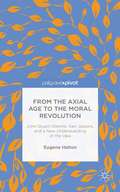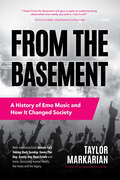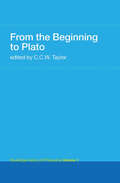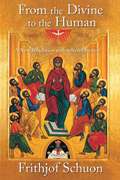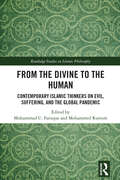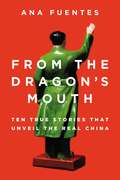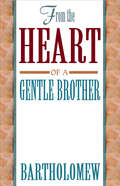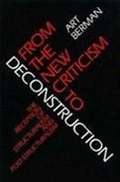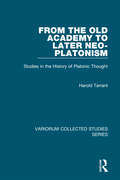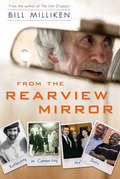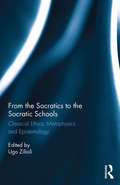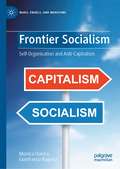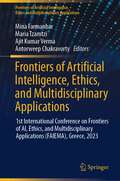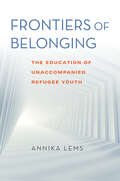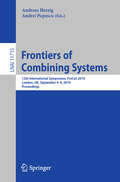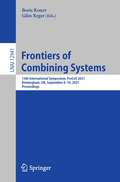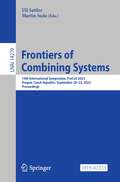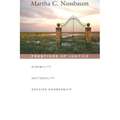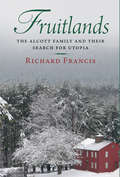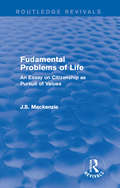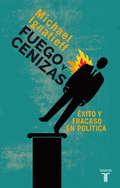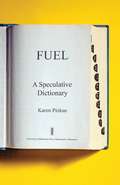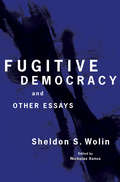- Table View
- List View
From the Axial Age to the Moral Revolution: John Stuart-Glennie, Karl Jaspers, and a New Understanding of the Idea
by Eugene HaltonIn 1873, John Stuart Stuart-Glennie elaborated a theory of 'the moral revolution' to characterize the historical shift from roughly 600 BCE in a variety of civilizations, as part of a critical theory of history. This book brings light to the now eclipsed theory and offers new contexts and understandings of the phenomenon.
From the Basement: A History of Emo Music and How It Changed Society
by Taylor Markarian Natasha Van Duser#1 New Release in Punk and Music Philosophy & Social Aspects, Theory, Composition & Performance - A Look at the History of the Emo and Indie Music EraExplore the cultural, social, and psychological factors surrounding the genres. Though songs can be timeless, music is often a result of the era in which it was created. The 2000s in music gave rise to indie, emo, and punk rock, carrying an emotional tone that has resonated with listeners ever since. Originally appealing to a small selection of music lovers, this music era now holds a significant place in the history of rock.The relationship between music and mental health. Music leaves its mark on the world by touching the hearts and minds of its creators and listeners. This book explores that connection and takes a look at what emo, alternative, and indie music did for the mental health of musicians and listeners.Inside stories from the music legends themselves. The voices of the rock musicians who contributed to these genres of music are just as important now as they were then. Author Taylor Markarian includes both her own interviews with bands and those from outside sources to provide an oral history and offer an authentic portrayal of these underground arts.Markarian’s book offers a comprehensive look into genres of music that have been simultaneously mocked and admired. Discover in From the Basement:The beauty and legitimacy of the gritty, wailing music that evolved into indie, alternative, and emoInsights from conversations with favorite emo/indie bands of the timeThe impact these genres have had on the millennial generation and today’s pop culture and mental healthExtensive coverage of bands like Save the Day, Dashboard Confessional, and My Chemical RomanceIf books such as Please Kill Me, American Hardcore, Meet Me in the Bathroom, and Sex, Drugs, and Cocoa Puffs have rocked your world, then From the Basement: A History of Emo Music and How It Changed Society should be your next read.Please note: A batch of printed copies mislabeled the band Hot Water Music as How Water Music. If you received a copy with this issue, please contact support@mango.bz to recieve a corrected copy of the book.
From the Beginning to Plato: Routledge History of Philosophy Volume 1 (Routledge History Of Philosophy Ser.)
by C. C. W. TaylorThis first volume in the series traces the development of philosophy over two-and-a-half centuries, from Thales at the beginning of the sixth century BC to the death of Plato in 347 BC.
From the Divine to the Human: A New Translation with Selected Letters
by Frithjof SchuonIn this book, which has been called a synthesis of his whole message, Frithjof Schuon invites us to explore aspects of humankind&’s relationship with the Divine, including our sense of the sacred, the conditions of our existence, the symbolism of the human body, and the question of accepting or refusing God&’s message. In doing so, Schuon paves the way for a true spiritual engagement. This revised edition has been fully retranslated and contains valuable editor&’s notes and a glossary, plus a fascinating appendix of previously unpublished writings.
From the Divine to the Human: Contemporary Islamic Thinkers on Evil, Suffering, and the Global Pandemic (Routledge Studies in Islamic Philosophy)
by Mohammed Rustom Muhammad U. FaruqueFeaturing the work of leading contemporary Muslim philosophers and theologians, this book grapples with various forms of evil and suffering in the world today, from COVID-19 and issues in climate change to problems in palliative care and human vulnerability. Rather than walking down well-trodden paths in philosophy of religion which often address questions of evil and suffering by focusing on divine attributes and the God-world relationship, this volume offers another path of inquiry by focusing on human vulnerability, potential, and resilience. Addressing both the theoretical and practical dimensions of the question of evil, topics range from the transformative power of love, virtue ethics in Sufism and the necessity of suffering, to the spiritual significance of the body and Islamic perspectives on embodiment. In doing so, the contributors propose new perspectives based on various pre-modern and contemporary materials that can enrich the emerging field of the global philosophy of religion, thereby radically transforming contemporary debates on the nature of evil and suffering. The book will appeal to researchers in a variety of disciplines, including Islamic philosophy, religious studies, Sufism, and theology.
From the Dragon's Mouth
by Ana FuentesWHO ARE THE CHINESE? Through on-the-ground interviews, Ana Fuentes uncovers the real China and offers a panoramic look at Chinese culture from the point of view of its citizens. She spent nearly 4 years living and working in China and discovered a world few have written about . . . until now. FROM THE DRAGON'S MOUTH: Ten True Stories that Unveil the Real China is an exquisitely intimate look into the China of the 21st century as seen through the eyes of its people. This is the first time that a book combines the voices of everyday Chinese people from so many different layers of society: a dissident tortured by the police; a young millionaire devoted to nationalism; a peasant-turnedprostitute to pay for the best education for her son; a woman who married her gay friend to escape from social pressure, just like an estimated 16 million other women; a venerable Kung-Fu master unable to train outdoors because of the hazardous pollution; the daughter of two Communist Party officials getting rich coaching Chinese entrepreneurs in the ways of Capitalism; among others. ANA FUENTES is a journalist whose reports have been broadcast on three continents by Radio Netherland, Prisa Radio, CNN en español and others. Ana holds a degree in Journalism from the Complutense University in Madrid and the Sorbonne University in Paris, and a Master's in Journalism from El País and the University Autonoma in Madrid.
From the Heart of a Gentle Brother
by BartholomewBartholomew will inspire you to love to the best of your heart's ability, to be accepting of all parts of your life, and to remember that there is a Power that exists, without question, and it helps to guide your life.
From the Knowledge Argument to Mental Substance
by Howard RobinsonThis book presents a strong case for substance dualism and offers a comprehensive defense of the knowledge argument, showing that materialism cannot accommodate or explain the 'hard problem' of consciousness. Bringing together the discussion of reductionism and semantic vagueness in an original and illuminating way, Howard Robinson argues that non-fundamental levels of ontology are best treated by a conceptualist account, rather than a realist one. In addition to discussing the standard versions of physicalism, he examines physicalist theories such as those of McDowell and Price, and accounts of neutral monism and panpsychism from Strawson, McGinn and Stoljar. He also explores previously unnoticed historical parallels between Frege and Aristotle and between Hume and Plotinus. His book will be a valuable resource for scholars and advanced students of philosophy of mind, in particular those looking at consciousness, dualism, and the mind-body problem.
From the New Criticism to Deconstruction: The Reception of Structuralism and Post-structuralism
by Art BermanThis book traces the transitions in America critical theory and practice from the 1950s to the 1980s. It also focuses on the influence of French structuralism and post-structuralism on American deconstruction within a wide-ranging context that includes literary criticism, philosophy, psychology, technology, and politics.
From the Old Academy to Later Neo-Platonism: Studies in the History of Platonic Thought (Variorum Collected Studies)
by Harold TarrantThis volume collects a set of papers on ancient Platonism that span the nine centuries between Plato himself and his commentator Olympiodorus in the 6th century, many of them less easy to obtain. Much of the work is at the intersection of philosophy and literature, and a recurrent aim is to challenge existing orthodoxies and to suggest alternatives. Two further related aims are to encourage the rereading of Plato in the light of the later tradition, and the tradition in the light of influential passages of Plato. The articles are grouped here in three sections, dealing first with Socrates, Plato and the Old Academy, then with the Platonic revival and the 2nd century AD, and finally with later Neoplatonism.
From the Rearview Mirror: Reflecting On Connecting The Dots
by Bill MillikenFrom the Rearview Mirror is the story of Bill Milliken’s journey from an affluent Pittsburgh suburb to the streets of Harlem and the Lower East Side of New York City in the 1960s, on to communal living in Georgia in the 1970s, to working with multiple presidential administrations in Washington, D.C. He struggled with an undiagnosed learning disability in school, believing he was dumb and had nowhere to go. After connecting with the Young Life outreach program at the age of 17, however, he found his calling doing street work with homeless, addicted, and other at-risk teens in the turbulent ’60s. Bill and his colleagues founded what grew into Communities in Schools, a highly effective organization working to bring services to young people and prevent them from dropping out of school. Along the way, Bill struggled with bringing his personal life into alignment with his ideals, coming to terms with organized religion and his own spiritual path, and creating the family and community he’d always longed for.
From the Socratics to the Socratic Schools: Classical Ethics, Metaphysics and Epistemology
by Ugo ZilioliIn the two golden centuries that followed the death of Socrates, ancient philosophy underwent a tremendous transformation that culminated in the philosophical systematizations of Plato, Aristotle and the Hellenistic schools. Fundamental figures other than Plato were active after the death of Socrates; his immediate pupils, the Socratics, took over his legacy and developed it in a variety of ways. This rich philosophical territory has however been left largely underexplored in the scholarship. This collection of eleven previously unpublished essays by leading scholars fills a gap in the literature, providing new insight into the ethics, metaphysics, and epistemology as developed by key figures of the Socratic schools. Analyzing the important contributions that the Socratics and their heirs have offered ancient philosophical thought, as well as the impact these contributions had on philosophy as a discipline, this book will appeal to researchers and scholars of Classical Studies, as well as Philosophy and Ancient History.
From the Tree to the Labyrinth
by Umberto EcoThe way we create and organize knowledge is the theme of From the Tree to the Labyrinth, a major achievement by one of the world's foremost thinkers on language and interpretation. Umberto Eco begins by arguing that our familiar system of classification by genus and species derives from the Neo-Platonist idea of a "tree of knowledge. " He then moves to the idea of the dictionary, which--like a tree whose trunk anchors a great hierarchy of branching categories--orders knowledge into a matrix of definitions. In Eco's view, though, the dictionary is too rigid: it turns knowledge into a closed system. A more flexible organizational scheme is the encyclopedia, which--instead of resembling a tree with finite branches--offers a labyrinth of never-ending pathways. Presenting knowledge as a network of interlinked relationships, the encyclopedia sacrifices humankind's dream of possessing absolute knowledge, but in compensation we gain the freedom to pursue an infinity of new connections and meanings. Moving effortlessly from analyses of Aristotle and James Joyce to the philosophical difficulties of telling dogs from cats, Eco demonstrates time and again his inimitable ability to bridge ancient, medieval, and modern modes of thought. From the Tree to the Labyrinth is a brilliant illustration of Eco's longstanding argument that problems of interpretation can be solved only in historical context.
Frontier Socialism: Self-Organisation and Anti-Capitalism (Marx, Engels, and Marxisms)
by Monica Quirico Gianfranco RagonaConsidering the history of workers' and socialist movements in Europe, Frontier Socialism focuses on unconventional forms of anti-capitalist thought, particularly by examining several militant-intellectuals whose legacy is of particular interest for those aiming for a radical critique of capitalism. Following on the work of Michael Löwy, Quirico & Ragona identify relationships of “elective affinity” between figures who might appear different and dissimilar, at least at first glance: the German Anarchist Gustav Landauer, the Bolshevik Alexandra Kollontai, the German communist Paul Mattick, the Italian Socialist Raniero Panzieri, the Greek-born French euro-communist Nikos Poulantzas, the German-born Swedish Social Democrat Rudolf Meidner, and the French social scientist Alain Bihr as well as two historical struggle experiences, the Spanish Republic and the Italian revolutionary group “Lotta continua”. Frontier Socialism then analyzes these thinkers' and experiences’ respective paths to socialism based on and achieved through self-organization and self-government, not to build a new tradition but to suggest a path forward for both research and political activism.
Frontiers of Artificial Intelligence, Ethics, and Multidisciplinary Applications: 1st International Conference on Frontiers of AI, Ethics, and Multidisciplinary Applications (FAIEMA), Greece, 2023 (Frontiers of Artificial Intelligence, Ethics and Multidisciplinary Applications)
by Ajit Kumar Verma Antorweep Chakravorty Mina Farmanbar Maria TzamtziThis groundbreaking proceedings volume explores the integration of Artificial Intelligence (AI) across key domains—healthcare, finance, education, robotics, industrial and other engineering applications —unveiling its transformative potential and practical implications. With a multidisciplinary lens, it transcends technical aspects, fostering a comprehensive understanding while bridging theory and practice. Approaching the subject matter with depth, the book combines theoretical foundations with real-world case studies, empowering researchers, professionals, and enthusiasts with the knowledge and tools to effectively harness AI. Encompassing diverse AI topics—machine learning, natural language processing, computer vision, data analytics and supervisory control — the volume showcases state-of-the-art techniques propelling AI advancements. Structured into four parts: Part 1: Artificial Intelligence (AI), explores evolving deep neural networks, reinforcement learning, and explainable AI, providing a deep dive into the technical foundations of AI advancements. Part 2: Robotics and Control Systems, delves into the integration of AI in robotics and automatic control, addressing supervisory control, automated robotic movement coordination, anomaly detection, dynamic programming, and fault tolerance, offering insights into the evolving landscape of intelligent automation. Part 3: AI and Society, examines the societal impact of AI through chapters on ethical considerations, economic growth, environmental engagements, and hazard management, providing a holistic perspective on AI's role in shaping society. Part 4: PhD Symposium, presents the future of AI through cutting-edge research, covering legal and ethical dimensions, privacy considerations, and computationally efficient solutions, offering a glimpse into the next generation of AI advancements. Catering to a diverse audience—from industry leaders to students—the volume consolidates the expertise of renowned professionals, serving as a comprehensive resource for navigating the ever-evolving AI landscape. An essential reference for those staying at the forefront of AI developments.
Frontiers of Belonging: The Education of Unaccompanied Refugee Youth (Worlds in Crisis: Refugees, Asylum, and Forced Migration)
by Annika LemsAs unprecedented numbers of unaccompanied African minors requested asylum in Europe in 2015, Annika Lems witnessed a peculiar dynamic: despite inclusionary language in official policy and broader society, these children faced a deluge of exclusionary practices in the classroom and beyond. Frontiers of Belonging traces the educational paths of refugee youth arriving in Switzerland amid the shifting sociopolitical terrain of the refugee crisis and the underlying hierarchies of deservingness. Lems reveals how these minors sought protection and support, especially in educational settings, but were instead treated as threats to the economic and cultural integrity of Switzerland. Each chapter highlights a specific child's story—Jamila, Meron, Samuel, and more—as they found themselves left out, while on paper being allowed "in." The result is a highly ambiguous social reality for young refugees, resulting in stressful, existential balancing acts. A captivating ethnography, Frontiers of Belonging allows readers into the Swiss classrooms where unspoken distinctions between self and other, guest and host, refugee and resident, were formed, policed, and challenged.
Frontiers of Combining Systems: 12th International Symposium, FroCoS 2019, London, UK, September 4-6, 2019, Proceedings (Lecture Notes in Computer Science #11715)
by Andreas Herzig Andrei PopescuThis book constitutes the proceedings of the 12th International Symposium on Frontiers of Combining Systems, FroCoS 2019, held in London, UK, in September 2019, colocated with the 28th International Conference on Automated Reasoning with Analytic Tableaux and Related Methods, TABLEAUX 2019. The 20 papers presented were carefully reviewed and selected from 30 submissions. They present research on the development of techniques and methods for the combination and integration of formal systems, their modularization and analysis. The papers are organized in the following topical sections: automated theorem proving and model building, combinations of systems, constraint solving, description logics, interactive theorem proving, modal and epistemic logics, and rewriting and unification.
Frontiers of Combining Systems: 13th International Symposium, FroCoS 2021, Birmingham, UK, September 8–10, 2021, Proceedings (Lecture Notes in Computer Science #12941)
by Giles Reger Boris KonevThis book constitutes the refereed proceedings of the 13th International Symposium on Frontiers of Combining Systems, FroCoS 2021, held in Birmingham, UK, in September 2021.
Frontiers of Combining Systems: 14th International Symposium, FroCoS 2023, Prague, Czech Republic, September 20–22, 2023, Proceedings (Lecture Notes in Computer Science #14279)
by Uli Sattler Martin SudaThis book constitutes the refereed proceedings of the 14th International Symposium on Frontiers of Combining Systems, FroCoS 2023, held in Prague, Czech Republic, in September 2023. The symposium was co-located with the 32nd International Conference on Automated Reasoning with Analytic Tableaux and Related Methods, TABLEAUX 2023.The 14 papers presented were thorouhgly reviewed and selected from the 22 high-quality paper submissions. They are grouped in the volume according to the following topic classification: analysis of programs and equations; unification; decidable fragments; frameworks; higher-order theorem proving.This is an open access book.
Frontiers of Justice: Disability, Nationality, Species Membership
by Martha C. Nussbaumgeneral and the timeless. Yet such theories, addressing the world and its problems, must respond to the real and changing dilemmas of the day. A brilliant work of practical philosophy, Frontiers of Justice is dedicated to this proposition. Taking up three urgent problems of social justice neglected by current theories and thus harder to tackle in practical terms and everyday life, Martha Nussbaum seeks a theory of social justice that can guide us to a richer, more responsive approach to social cooperation.<P><P> The idea of the social contract--especially as developed in the work of John Rawls--is one of the most powerful approaches to social justice in the Western tradition. But as Nussbaum demonstrates, even Rawls's theory, suggesting a contract for mutual advantage among approximate equals, cannot address questions of social justice posed by unequal parties. How, for instance, can we extend the equal rights of citizenship--education, health care, political rights and liberties--to those with physical and mental disabilities? How can we extend justice and dignified life conditions to all citizens of the world? And how, finally, can we bring our treatment of nonhuman animals into our notions of social justice? Exploring the limitations of the social contract in these three areas, Nussbaum devises an alternative theory based on the idea of "capabilities." She helps us to think more clearly about the purposes of political cooperation and the nature of political principles--and to look to a future of greater justice for all.
Fruitlands: The Alcott Family and Their Search for Utopia
by Richard FrancisThis is the first definitive account of Fruitlands, one of history's most unsuccessful--but most significant--utopian experiments. It was established in Massachusetts in 1843 by Bronson Alcott (whose ten-year-old daughter Louisa May, future author of Little Women,was among the members) and an Englishman called Charles Lane, under the watchful gaze of Emerson, Thoreau, and other New England intellectuals. Alcott and Lane developed their own version of the doctrine known as Transcendentalism, hoping to transform society and redeem the environment through a strict regime of veganism and celibacy. But physical suffering and emotional conflict--particularly between Lane and Alcott's wife, Abigail--made the community unsustainable. Drawing on the letters and diaries of those involved, Richard Francis explores the relationship between the complex philosophical beliefs held by Alcott, Lane, and their fellow idealists and their day-to-day lives. The result is a vivid and often very funny narrative of their travails, demonstrating the dilemmas and conflicts inherent to any utopian experiment and shedding light on a fascinating period of American history.
Fudamental Problems of Life: An Essay on Citizenship as Pursuit of Values (Routledge Revivals)
by J.S. MackenzieIn this volume, originally published in 1928, Mackenzie explores the meaning of Value and its place and relation in human thought and life. Divided into two parts, the first concerns itself with more general problems concerning Value while the latter part details the bearing Value has upon social problems. Mackenzie integrates the major branches of philosophy (Logic, Ethics, Metaphysics and Aesthetics) to analyse and evaluate the fundamental problems of citizenship making this title ideal for students of Philosophy and Politics.
Fuego y cenizas. Éxito y fracaso en política
by Michael IgnatieffEl libro que todos los votantes y líderes deberían leer. Una dosis de optimismo para quienes han perdido la fe en los políticos. «Un distinguido intelectual, escritor, periodista y académico deja su biblioteca y su cátedra de Harvard para emprender una carrera política en el más alto nivel, y durante seis años experimenta la pasión y la excitación, el entusiasmo y la intriga, el fracaso y el éxito de los partidos políticos en el amplio escenario canadiense. Seis años después de su inmersión en la vida política, regresa a su biblioteca, se dedica a la reflexión y nos ofrece un relato increíblemente revelador y honesto de esa aventura. Este libro es una brújula que ayudará al lector a encontrar su camino en el vertiginoso laberinto en que la política se ha convertido en las grandes democracias modernas.» Mario Vargas Llosa Fuego y cenizas es una inmersión en la salvaje vida política moderna, y una contribución esencial al debate sobre la participación en ella. ¿Está justificada la pérdida de la fe en la política democrática? ¿Hacen bien en conservarla los idealistas? En un momento en que la ciudadanía reclama con fuerza transparencia y ética, Ignatieff refleja la política como una materia cruel, impredecible e implacable, pero ofrece argumentos para que sigamos creyendo. La crítica ha dicho...«Un relato convincente y emocionante. Si lo que se busca es un texto clarividente, fruto de una aguda observación, mordaz pero a fin de cuentas esperanzador sobre la política contemporánea, este relato es muy difícil de superar.»David Runciman, The Guardian «Las librerías están repletas de memorias escritas por políticos exitosos, cuyo relato de sus carreras brilla con el resplandor de las batallas ganadas. La versión de Michael Ignatieff consta de ingredientes muy distintos: humildad, descubrimiento de sí mismo y humanidad.»Anne-Marie Slaughter, Universidad de Princeton «Fuego y cenizas sirve a muchas gente. Al ciudadano normal (porque eso existe, ¿no?), al político profesional y al que quiera dedicarse a la política. Al ciudadano normal le interesa saber cómo es eso de dejarse arrastrar por una mezcla de idealismo y vanidad, caer en manos de los profesionales del aparato y salir trasquilado.»José Manuel Calvo, Babelia «Lo mejor: sin pelos en la lengua al referirse a la ambición, la crueldad o la inconsistencia de los políticos. Recomendado para quienes consideran, como el propio Ignatieff, que, pese a todo, la política no es solo un juego sucio y la democracia merece la pena.»ABC Cultural «Michael Ignatieff ha relatado en Fuego y cenizas. Éxito y fracaso en política su fallida experiencia como líder en el Partido Liberal de Canadá. El libro, tan brillante como todas su obras, es la mirada atónita y perpleja de una reciénllegado a proceloso interior de un partido político.»Lucía Méndez, El Mundo «Esa rareza: una biografía política conmovedora. [...] Ha aprendido lo que es el combate político y nosotros nos alegramos de conocer a un hombre decente.»Diego Manrique, Babelia «Extraordinario. Fuego y cenizas es un brillante testimonio sobre el estado de la política y una advertencia sobre los peligros y los placeres de la vida política. De lectura obligada para cualquiera que esté contemplando una carrera política.»Robert Collison, Toronto Star «Cautivadoramente sincero, Ignatieff ha escrito un libro elegante, minucioso y franco.»Peter Clarke, Financial Times «Un relato honesto, repleto de una sabiduría alcanzada tras mucho esfuerzo.»John Ivison, National Post
Fuel: A Speculative Dictionary (Posthumanities #39)
by Karen PinkusFuel is an idiosyncratic, speculative dictionary of fuels, real and imagined, historical and futuristic, hopeless and utopian. Drawing on literature, film, and scientific treatises—most produced long before &“climate change&” was in circulation—Fuel argues for a distinction between energy (a system of power) and fuel (a substance, which can be thought of as &“potentiality&”) as it endeavors to undo the dream that we can simply switch to renewables and all will be golden.From &“Air&” to &“Zyklon B,&” entries in this unusual &“dictionary&” include Algae, Clathrates, Dilithium, Fleece, Goats, Theology, Whale Oil, and many, many more. The tone of the entries ranges as widely as the topics: from historical anecdotes (the Ford Fiesta &“boozemobile&”) to eccentric readings of the classics of &“energy lit&” (Germinal and Oil!); from literary observations (a high octane Odyssey?) to excursions into literary theory. The dictionary draws from an eccentric canon, including works by Jules Verne, George Eliot&’s Silas Marner, Paolo Bacigalupi&’s Windup Girl, and the Tom Cruise vehicle Oblivion, among others. A message from this ambitious project is that energy can be understood as a heterogeneous set of self-mystifying systems or machines that block access to thought as they fascinate us. Fuels emerge as more primal elements that the audience can grasp at various points along the way to consumption/combustion. This dictionary can help scramble our thinking about fuel—not in order to demonize energy and not in order to create a new hierarchy in which certain renewables take over from fossil fuels but instead to open up potential ways of interacting with real and imaginary substances, by wrenching them out of narrative and placing them into an idiosyncratic dictionary to be applied by readers into new narratives.
Fugitive Democracy: And Other Essays
by Sheldon S. Wolin Nicholas XenosSheldon Wolin was one of the most influential and original political thinkers of the past fifty years. Fugitive Democracy brings together his most important writings, from classic essays such as "Political Theory as a Vocation," written amid the Cold War and the conflict in Vietnam, to his late radical essays on American democracy such as "Fugitive Democracy," in which he offers a controversial reinterpretation of democracy as an episodic phenomenon distinct from the routinized political management that passes for democracy today.The breathtaking range of Wolin's scholarship, political commitment, and critical acumen are on full display in this authoritative and accessible collection. He critically engages a diverse range of political theorists, including Thomas Hobbes, Karl Marx, Max Weber, Hannah Arendt, John Rawls, Michel Foucault, and Richard Rorty. These essays grapple with topics such as power, modernization, the sixties, revolutionary politics, and inequality, all the while showcasing Wolin's enduring commitment to writing civic-minded theoretical commentary on the most pressing political issues of the day. Here, Wolin laments the rise of conservatives who style themselves as revolutionary, criticizes Rawlsian liberals as abstract to the point of being apolitical, diagnoses postmodern theory as a form of acquiescence, and much more.Fugitive Democracy offers enduring insights into many of today's most pressing political predicaments, and introduces a whole new generation of readers to this provocative figure in contemporary political thought.
